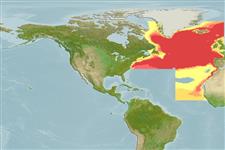Environment: milieu / climate zone / depth range / distribution range
Ecologie
marien bathypelagisch; diepte 0 - 3000 m (Ref. 27000). Deep-water; 73°N - 10°N, 77°W - 1°W
Eastern Atlantic: scattered records from Greenland to Cape Verde. Also known from Western Atlantic.
Grootte / Gewicht / Leeftijd
Maturity: Lm ? range ? - ? cm
Max length : 161 cm TL mannelijk / geslacht onbekend; (Ref. 27000)
Bathypelagic (Ref. 58426). Feeds on fishes. Oviparous, reduction of jaws and complete loss of teeth in sexually mature specimens of both sexes. Mature males with greatly enlarged olfactory organs (Ref. 6718). Minimum depth from Ref. 58018.
Levenscyclus en paargedrag
Maturiteit | Voortplanting | Paaien | Eieren | Fecunditeit | Larven
Nielsen, J.G. and E. Bertelsen, 1990. Saccopharyngidae. p. 204-205. In J.C. Quero, J.C. Hureau, C. Karrer, A. Post and L. Saldanha (eds.) Check-list of the fishes of the eastern tropical Atlantic (CLOFETA). JNICT, Lisbon; SEI, Paris; and UNESCO, Paris. Vol. 1. (Ref. 6539)
Status op de Rode Lijst van het IUCN (Ref. 130435)
Gevaar voor de mens
Harmless
Gebruik door de mens
Meer informatie
Lokale namenSynoniemenMetabolismePredatorenEcotoxicologieVoortplantingMaturiteitPaaienPaaiaggregatiesFecunditeitEierenOntwikkeling van de eieren
Leeftijd/Grootte
Groei
Lengte-gewicht
Lengte-lengte
Lengtefrequenties
Morfometrie
Morfologie
Larven
Larvale populatiedynamiek
Rekrutering
Abundantie
BRUVS
ReferentiesAquacultuurAquacultuurprofielKweeklijnenGeneticaElectrophoresesErfelijkheidZiektesVerwerkingNutrientsMassaconversie
Tools
Speciale rapporten
Download XML
Internetbronnen
Estimates based on models
Preferred temperature (Ref.
123201): 2.1 - 11.1, mean 6.1 °C (based on 371 cells).
Fylogenetische diversiteitsindex (Ref.
82804): PD
50 = 0.5020 [Uniqueness, from 0.5 = low to 2.0 = high].
Bayesian length-weight: a=0.00102 (0.00046 - 0.00225), b=3.06 (2.88 - 3.24), in cm total length, based on all LWR estimates for this body shape (Ref.
93245).
Trofisch niveau (Ref.
69278): 4.5 ±0.80 se; based on food items.
Weerstandsvermogen (Ref.
120179): Zeer laag, minimale populatieverdubbelingstijd meer dan 14 jaar (Assuming semelparity and tm>10).
Fishing Vulnerability (Ref.
59153): Very high vulnerability (90 of 100).
